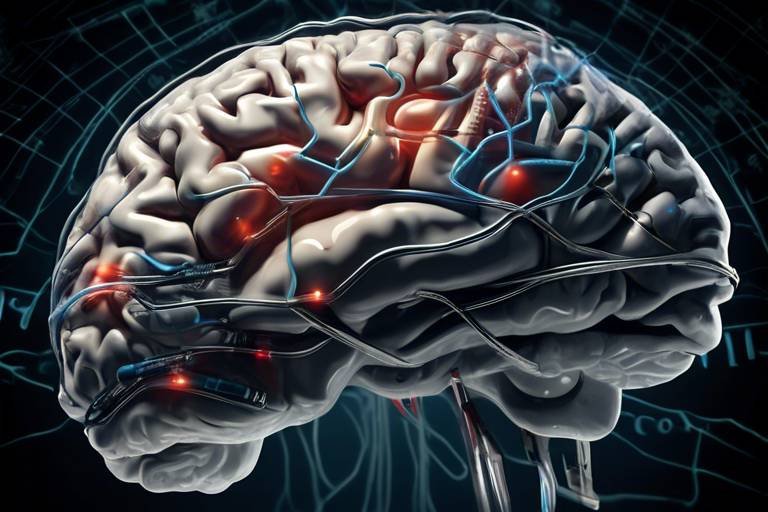Science, Morality, and Animal Rights
The intersection of science, morality, and animal rights is a complex tapestry woven from threads of ethical considerations, scientific advancements, and societal values. In today’s world, where technological progress is racing ahead, it’s crucial to pause and reflect on how our treatment of animals aligns with our moral compass. As we delve deeper into this multifaceted relationship, we uncover the implications of scientific research on animal welfare and the ethical dilemmas that arise in the quest for knowledge.
At the heart of this discussion lies a fundamental question: What responsibilities do we have towards animals in our pursuit of scientific understanding? This question doesn't just challenge researchers and policymakers; it also prompts each of us to consider our own beliefs and actions regarding animal rights. As we explore this topic, we will examine the evolution of animal rights, the role of ethics in scientific research, and the philosophical perspectives that shape our views on the treatment of animals.
In recent years, there has been a notable shift in public perception regarding animal rights. With the rise of advocacy groups and increased media coverage, more people are becoming aware of the plight of animals used in research. This growing awareness has led to significant changes in legislation and research practices, pushing for greater transparency and accountability in how animals are treated. The challenge lies in balancing the need for scientific progress with the ethical obligation to ensure the welfare of sentient beings.
As we navigate this intricate landscape, it’s essential to recognize that the dialogue surrounding animal rights is not merely a scientific or ethical issue; it is a reflection of our collective values as a society. Our choices today will shape the future of animal rights and the ethical frameworks that govern our interactions with the animal kingdom. By understanding the historical context and current debates, we can better appreciate the significance of animal rights in the broader conversation about morality and science.
Understanding the historical context of animal rights is crucial. The movement has evolved significantly over the years, with its roots tracing back to various philosophical and ethical considerations. Early advocates, such as Jeremy Bentham, questioned the moral status of animals, famously asking, "Can they suffer?" This pivotal inquiry laid the groundwork for subsequent movements aimed at protecting animal welfare.
As society progressed, so did the recognition of animals as beings deserving of rights. The establishment of organizations like the Royal Society for the Prevention of Cruelty to Animals (RSPCA) in the 19th century marked a significant milestone in the fight against animal cruelty. Today, animal rights advocacy continues to gain momentum, fueled by a growing awareness of the ethical implications of our actions toward animals.
Scientific research has a profound impact on animal welfare, raising important ethical questions about the treatment of animals in laboratories. Ethical guidelines and regulations have been established to ensure that animal research is conducted humanely and responsibly. Researchers are now required to adhere to the 3Rs principle: Replace, Reduce, and Refine. This principle encourages scientists to find alternatives to animal testing, minimize the number of animals used, and improve the conditions in which they are kept.
Ethics play a vital role in guiding researchers as they navigate the complexities of animal research. Ethical frameworks help establish a balance between the pursuit of scientific knowledge and the respect for animal rights. Researchers are encouraged to consider the potential benefits of their work against the suffering it may cause to animal subjects. This ethical consideration is not just a formality; it is a fundamental aspect of responsible research practices.
Various regulatory frameworks govern animal research, emphasizing the importance of compliance in ensuring animal welfare. These frameworks include national laws and international agreements, which set standards for the treatment of animals in research settings. Organizations like the Institutional Animal Care and Use Committee (IACUC) play a crucial role in overseeing research protocols, ensuring that ethical standards are upheld.
Innovative alternatives to animal testing are emerging as technology advances. Methods such as in vitro testing, computer modeling, and organ-on-a-chip technologies are reducing the reliance on animal subjects. These alternatives not only enhance scientific accuracy but also align with the growing demand for ethical research practices. The shift toward these methods signifies a promising future for both scientific discovery and animal rights.
Public perception significantly influences animal rights advocacy. As societal attitudes toward animals evolve, so do the laws and regulations governing their treatment. Increased awareness of animal suffering has led to a surge in advocacy efforts, pushing for stricter regulations on animal testing and greater protections for animals in various industries. This shift reflects a growing recognition that animals are not mere commodities, but beings deserving of respect and compassion.
Examining philosophical perspectives provides insight into the moral arguments surrounding animal rights. Various ethical theories, such as utilitarianism and rights-based approaches, offer different frameworks for understanding our responsibilities toward animals. These perspectives shape not only how we view animals but also how we justify our actions in relation to them.
Utilitarianism emphasizes the greatest good for the greatest number, often prioritizing human interests over animal welfare. In contrast, rights-based approaches argue that animals possess inherent rights that must be respected, regardless of the potential benefits to humans. This contrast highlights the ongoing debate about the ethical treatment of animals and the moral implications of our choices.
The concept of sentience is pivotal in the animal rights debate. Understanding that animals can experience pain, pleasure, and a range of emotions fundamentally changes how we perceive our obligations toward them. Recognizing sentience compels us to reconsider our practices and advocate for more humane treatment of all living beings.
- What is the main goal of animal rights advocacy? The primary goal is to ensure that animals are treated with respect and compassion, and to prevent cruelty and exploitation.
- How does scientific research impact animal welfare? Scientific research can both positively and negatively impact animal welfare, depending on the ethical considerations and regulations in place.
- What are the 3Rs in animal research? The 3Rs stand for Replace, Reduce, and Refine, guiding researchers to minimize animal use and suffering.
- Are there alternatives to animal testing? Yes, advancements in technology have led to various alternatives, including in vitro testing and computer simulations.
- Why is sentience important in the animal rights debate? Acknowledging sentience emphasizes that animals can suffer and feel, which is crucial for advocating for their rights and welfare.

The Evolution of Animal Rights
Understanding the historical context of animal rights is crucial for grasping the complexities of the movement today. The journey toward recognizing the rights of animals has been long and multifaceted, intertwining with various cultural, philosophical, and scientific developments. The roots of the animal rights movement can be traced back to ancient civilizations, where some cultures revered animals, while others viewed them merely as resources. However, it wasn't until the Enlightenment period that the first significant philosophical arguments for animal rights began to emerge.
During the 18th century, thinkers like Jeremy Bentham and Immanuel Kant laid the groundwork for modern discussions on animal welfare. Bentham famously argued that the capacity to suffer, rather than the ability to reason, should determine how we treat other beings. This shift in perspective was revolutionary, prompting society to reconsider its treatment of animals. Fast forward to the 19th century, and we see the establishment of organizations like the Royal Society for the Prevention of Cruelty to Animals (RSPCA) in the UK, which marked a significant milestone in the formalization of animal rights advocacy.
As we moved into the 20th century, the movement gained momentum with influential figures such as Peter Singer, whose book Animal Liberation (1975) challenged the status quo and argued for the moral consideration of animals. Singer's work catalyzed a wave of activism, leading to the formation of various animal rights organizations and campaigns aimed at raising awareness about animal suffering in industries such as farming, entertainment, and research.
The evolution of animal rights has not been without its challenges. The debate often centers around the balance between scientific progress and the ethical treatment of animals. As scientific research advanced, so did the complexity of the arguments surrounding animal rights. Advocates began to push for regulations that would protect animals used in laboratories, leading to the establishment of ethical guidelines and laws aimed at minimizing suffering.
Today, the animal rights movement encompasses a wide range of issues, from the treatment of pets to the conditions of farm animals and the use of animals in scientific research. The movement has evolved into a global phenomenon, with activists leveraging social media and other platforms to spread their message and advocate for change. The rise of veganism and plant-based diets reflects a broader shift in societal attitudes toward animals, emphasizing compassion and ethical considerations in our daily choices.
In summary, the evolution of animal rights is a testament to humanity's growing awareness of moral responsibility towards other sentient beings. As we continue to grapple with ethical dilemmas and scientific advancements, the conversation around animal rights will undoubtedly evolve further, challenging us to reflect on our values and the impact of our actions on the lives of animals.
- What is the main goal of the animal rights movement? The primary goal is to ensure that animals are treated with respect and compassion, advocating for their rights and welfare across various sectors.
- How has public perception of animal rights changed over time? Public perception has shifted significantly, with increasing awareness and empathy towards animal suffering, leading to more advocacy and legislative changes.
- Are there laws protecting animal rights? Yes, many countries have laws in place to protect animals from cruelty and ensure humane treatment, although enforcement and comprehensiveness vary widely.
- What role does education play in the animal rights movement? Education is crucial in raising awareness about animal suffering and promoting ethical treatment, helping to inform public opinion and influence policy changes.

Scientific Research and Animal Welfare
Scientific research has always been a double-edged sword, especially when it comes to the welfare of animals. On one hand, it has led to groundbreaking discoveries that have improved human health and understanding of biological processes. On the other hand, it often involves the use of animals in experiments, raising significant ethical concerns. This delicate balance between advancing science and ensuring humane treatment of animals is at the heart of ongoing debates in contemporary society.
As we delve into this complex relationship, it's essential to recognize that the use of animals in research is governed by a myriad of ethical guidelines and regulations. These frameworks aim to minimize suffering and ensure that any research involving animals is justified by its potential benefits. For instance, researchers are required to demonstrate that their studies cannot be conducted using alternative methods, such as computer modeling or cell cultures. This necessity to justify animal use is a critical aspect of ethical research practices.
Ethics play a vital role in guiding scientific research involving animals. Researchers are often encouraged to adhere to the "Three Rs" principle: Replacement, Reduction, and Refinement. This principle advocates for replacing animal models with alternatives whenever possible, reducing the number of animals used in experiments, and refining procedures to minimize pain and distress. By following these guidelines, scientists can pursue their research goals while respecting the rights and welfare of animal subjects.
Various regulatory frameworks exist globally to oversee animal research and ensure compliance with ethical standards. In the United States, the Animal Welfare Act (AWA) is a key piece of legislation that sets the minimum standards for the care and treatment of animals used in research. Similarly, the European Union has stringent regulations that require all animal research to be reviewed and approved by ethical committees. These frameworks not only protect animals but also enhance the credibility of scientific research by ensuring that it is conducted responsibly.
As technology advances, researchers are increasingly exploring innovative alternatives to animal testing. These alternatives not only align with ethical considerations but also offer the potential for more accurate and efficient results. For example, in vitro testing using human cell cultures can provide insights into human biology without the ethical dilemmas associated with animal experimentation. Moreover, advancements in computational biology allow scientists to simulate biological processes, reducing the reliance on animal models. The shift toward these alternatives is not just a trend; it's a necessary evolution in the pursuit of ethical and effective scientific research.
In conclusion, the intersection of scientific research and animal welfare is a complex landscape that requires careful navigation. As society continues to evolve, so too must our approaches to research involving animals. By prioritizing ethical considerations, embracing regulatory frameworks, and exploring innovative alternatives, we can strive for a future where scientific advancement and animal welfare coexist harmoniously.
- What are the ethical guidelines for animal research? Ethical guidelines typically include the "Three Rs": Replacement, Reduction, and Refinement, which aim to minimize animal suffering and promote humane treatment.
- What regulatory frameworks govern animal research? In the U.S., the Animal Welfare Act (AWA) sets minimum standards for the care and treatment of animals in research. In the EU, similar regulations exist to ensure ethical compliance.
- Are there alternatives to animal testing? Yes, alternatives include in vitro testing using human cell cultures and computational biology, which can simulate biological processes without the need for animal subjects.

The Role of Ethics in Research
When we think about scientific research, especially involving animals, the term ethics often pops up. Why is that? Well, ethics serves as the moral compass guiding researchers through the complex landscape of experimentation. Imagine you're navigating a dense forest; without a map, you could easily lose your way. Similarly, ethics helps researchers make decisions that respect animal rights while still pushing the boundaries of scientific knowledge.
One of the fundamental ethical frameworks that guide animal research is the Three Rs principle: Replacement, Reduction, and Refinement. This principle encourages researchers to:
- Replace animal experiments with alternative methods whenever possible.
- Reduce the number of animals used in experiments to the minimum required to achieve valid results.
- Refine procedures to minimize suffering and enhance animal welfare.
These guidelines not only promote humane treatment but also enhance the quality of research outcomes. By considering ethical implications, researchers are more likely to design studies that yield reliable and applicable results. It's like tuning a musical instrument; when done right, the performance resonates beautifully, benefiting both the audience and the musician.
Moreover, ethics in research is not just about compliance with regulations; it's about fostering a culture of responsibility and respect for all living beings. Researchers are encouraged to engage in ethical deliberation, asking themselves critical questions such as:
- Is the potential knowledge gained worth the cost to animal welfare?
- Are there alternative methods that could achieve similar results without harming animals?
- How can I ensure that the animals in my study are treated with the utmost care and respect?
These questions are vital because they help researchers reflect on their motivations and the broader implications of their work. In a world increasingly aware of animal rights, ethical considerations are becoming more than just a checkbox; they are an integral part of the scientific process.
In conclusion, the role of ethics in research is multifaceted and essential. It not only shapes the way studies are designed and conducted but also influences public perception and trust in scientific endeavors. As we continue to advance in various fields, the conversation around ethics will undoubtedly evolve, pushing us to reevaluate our responsibilities toward the animals that share our planet. This ongoing dialogue is crucial, ensuring that while we seek knowledge, we do not lose sight of compassion and respect for all living beings.
- What are the Three Rs in animal research? The Three Rs are Replacement, Reduction, and Refinement, guiding ethical practices in animal research.
- Why is ethics important in animal research? Ethics ensures that animals are treated humanely and that their suffering is minimized, while also enhancing the quality of scientific outcomes.
- How can researchers ensure they are following ethical guidelines? Researchers should engage in ethical deliberation, consult relevant regulations, and consider alternative methods to reduce animal use.

Regulatory Frameworks
When it comes to the intersection of science and animal rights, are absolutely essential. These frameworks are designed to ensure that animal research is conducted ethically and humanely, balancing the pursuit of scientific knowledge with the welfare of animals. In many countries, laws and regulations dictate how animals can be used in research, and these guidelines are continually evolving to reflect changing societal values and scientific advancements.
In the United States, the Animal Welfare Act (AWA) serves as the cornerstone of animal protection legislation. This law sets standards for the care and treatment of animals used in research, exhibition, and transport. Under the AWA, facilities that conduct research involving animals must be licensed and are subject to regular inspections. This regulatory oversight is crucial, as it helps to prevent abuse and ensure that animals are treated with respect and dignity.
In addition to the AWA, various organizations play a pivotal role in shaping animal research regulations. The Institutional Animal Care and Use Committee (IACUC) is one such body that reviews research proposals involving animals to ensure compliance with ethical standards. Researchers must submit their plans to the IACUC, which evaluates the necessity of using animals, the proposed methods, and the measures in place to minimize suffering. This process not only safeguards animal welfare but also fosters a culture of responsibility among researchers.
Moreover, international frameworks, such as the European Union's Directive 2010/63/EU, set stringent guidelines for the use of animals in research across member states. This directive emphasizes the principles of the 3Rs: Replacement, Reduction, and Refinement. These principles aim to replace animal testing with alternative methods whenever possible, reduce the number of animals used in experiments, and refine procedures to minimize suffering. By adhering to these guidelines, researchers can conduct their work while maintaining ethical integrity.
As we move forward, it is essential to recognize that regulatory frameworks are not static; they must adapt to new scientific discoveries and societal expectations. For instance, advancements in technology, such as in vitro testing and computer modeling, are paving the way for alternatives to traditional animal testing. Regulatory bodies must stay informed and consider these innovations to ensure that regulations remain relevant and effective.
In conclusion, regulatory frameworks are the backbone of ethical animal research. They provide a structured approach to ensuring that animals are treated humanely while allowing for scientific progress. As public awareness and advocacy for animal rights continue to grow, it is crucial for these frameworks to evolve in tandem, reflecting the values and expectations of society.
- What is the purpose of regulatory frameworks in animal research? Regulatory frameworks aim to ensure the ethical treatment of animals used in research while allowing for scientific advancements.
- What are the 3Rs in animal research? The 3Rs stand for Replacement, Reduction, and Refinement, which are principles aimed at minimizing the use of animals in research.
- How does the IACUC contribute to animal welfare? The IACUC reviews research proposals to ensure that animal welfare standards are met and that researchers are taking necessary precautions to minimize suffering.
- Are there alternatives to animal testing? Yes, advancements in technology, such as in vitro testing and computer modeling, provide alternatives to traditional animal testing methods.

Alternatives to Animal Testing
As society progresses, the demand for ethical research practices grows stronger, leading to innovative alternatives to animal testing. This shift is not just a trend; it reflects a deeper understanding of our moral obligations towards animals and a commitment to finding methods that do not involve their suffering. The quest for alternatives has sparked a wave of technological advancements, which are reshaping the landscape of scientific research.
One of the most promising alternatives is the use of in vitro testing, which involves studying cells and tissues in a controlled environment outside of a living organism. This method allows researchers to observe biological responses without the ethical dilemmas posed by animal testing. For instance, scientists can utilize human cell cultures to evaluate toxicity or drug efficacy, providing results that are often more relevant to human health.
Moreover, the rise of computer modeling and simulations has revolutionized the way researchers predict the effects of substances. These sophisticated algorithms can analyze vast amounts of data to simulate how a drug will interact with human biology. This method not only reduces the need for animal subjects but also accelerates the research process, allowing for quicker advancements in medicine and safety testing.
Another innovative approach is the development of organ-on-a-chip technology. These tiny devices replicate the functions of human organs, enabling scientists to test drugs and chemicals in a more accurate environment. Think of it as a miniature laboratory that mimics real biological systems, providing invaluable insights while eliminating the need for live animals. This technology is paving the way for a future where animal testing becomes obsolete.
In addition to these technological advancements, researchers are also turning to human volunteers for certain types of studies, particularly in the field of pharmacology. By using microdosing techniques, scientists can administer small, non-harmful doses of a drug to human participants to assess its effects without the ethical concerns associated with animal testing. This method not only respects animal rights but also provides data that is directly applicable to human health.
While these alternatives are promising, it’s essential to recognize that they are not a one-size-fits-all solution. Some complex biological interactions can only be studied in whole organisms. However, the continuous development of alternative methods is encouraging and represents a significant step towards a more humane approach to research. As we move forward, it is crucial for the scientific community to prioritize these alternatives and for regulatory bodies to support their implementation.
In conclusion, the shift towards alternatives to animal testing is not just a matter of ethics; it is a reflection of our evolving understanding of science and morality. By embracing these innovative methods, we can ensure that our quest for knowledge does not come at the expense of our fellow creatures. The future of research is bright, and with continued investment in these technologies, we can look forward to a world where animal testing is merely a chapter in the history of science.
- What are the main alternatives to animal testing?
The main alternatives include in vitro testing, computer modeling, organ-on-a-chip technology, and human volunteer studies.
- Are alternative methods as effective as animal testing?
Many alternative methods can provide more relevant data for human health, but some complex biological interactions still require whole organisms for study.
- How can regulatory bodies support alternatives to animal testing?
Regulatory bodies can support alternatives by approving new methods, providing funding for research, and encouraging the adoption of these technologies in scientific practices.

Public Perception and Advocacy
The relationship between public perception and animal rights advocacy is a fascinating one, often resembling a dance where each step influences the other. As society evolves, so do its attitudes toward animals, which in turn shapes the legislative landscape and the practices of scientific research. It's essential to understand that public sentiment is not just a passive observer; it actively drives change and sets the tone for how animals are treated across various sectors.
For instance, consider how the rise of social media has transformed advocacy efforts. In today's digital age, a single viral video can spark outrage and mobilize thousands of people to demand justice for animals. This swift response illustrates the power of public perception in influencing animal rights legislation. When people see the plight of animals, whether through heart-wrenching images or compelling stories, it ignites a sense of urgency that can lead to significant changes in laws and practices. The public's emotional connection to animals often translates into a demand for better treatment and stricter regulations, pushing organizations and governments to act.
Moreover, public perception is significantly shaped by educational initiatives and awareness campaigns. Organizations dedicated to animal welfare often utilize various platforms to inform the public about the ethical implications of animal testing and the benefits of adopting cruelty-free practices. These campaigns can take many forms, including:
- Documentaries highlighting the realities of animal testing.
- Social media campaigns that engage younger audiences.
- Community events that promote adoption and responsible pet ownership.
These efforts not only raise awareness but also cultivate empathy, encouraging people to reconsider their choices and advocate for animal rights. It's a ripple effect; as more individuals become informed, they share their knowledge with others, creating a community of advocates who are passionate about animal welfare.
However, it's important to recognize that public perception is not always consistent. There are still significant gaps in understanding, and not everyone is on board with the idea of prioritizing animal rights. Some may argue that scientific progress should take precedence over animal welfare, citing the need for medical advancements and research. This dichotomy can lead to heated debates, highlighting the need for ongoing dialogue and education. Advocacy groups must navigate these complexities, striving to bridge the gap between differing viewpoints while promoting a compassionate approach to animal rights.
In conclusion, the interplay between public perception and advocacy is a dynamic and evolving relationship. By harnessing the power of education, emotional storytelling, and social media, advocates can effectively influence public sentiment, ultimately leading to a more humane society for all living beings. As we continue to make strides in understanding the ethical treatment of animals, it's crucial for advocates to remain vigilant and adaptable, ensuring that the voices of the voiceless are heard loud and clear.
| Question | Answer |
|---|---|
| What role does social media play in animal rights advocacy? | Social media amplifies awareness, allowing advocates to share stories and mobilize support quickly and effectively. |
| How can I get involved in animal rights advocacy? | You can start by educating yourself, supporting local shelters, participating in campaigns, and advocating for humane legislation. |
| Are there any risks associated with animal testing? | Yes, animal testing raises ethical concerns regarding the treatment of animals and the validity of results in relation to human health. |

Philosophical Perspectives on Animal Rights
The debate surrounding animal rights is not just a matter of compassion; it is deeply rooted in philosophical inquiry. Philosophers have long pondered the moral implications of our treatment of animals, leading to a rich tapestry of thought that informs contemporary discussions on the subject. From the ancient Greeks to modern thinkers, the question of whether animals deserve rights and what those rights entail has sparked fierce debate. This exploration of philosophical perspectives reveals the complexity of animal rights, showcasing how different ethical frameworks shape our understanding and treatment of non-human beings.
One of the most prominent frameworks in this discourse is utilitarianism, which argues that the rightness or wrongness of actions is determined by their consequences. In the context of animal rights, utilitarian thinkers, like Jeremy Bentham and Peter Singer, assert that the capacity to suffer is what grants animals moral consideration. Bentham famously stated, “The question is not, Can they reason? nor, Can they talk? but, Can they suffer?” This perspective emphasizes the importance of minimizing suffering, leading to arguments for better treatment of animals in various sectors, including agriculture and scientific research.
However, utilitarianism faces criticism for its potential to justify harmful practices if they result in a greater overall good. Critics argue that it can lead to a slippery slope where the suffering of a few is deemed acceptable for the benefit of many. This concern has led to the development of rights-based approaches, which argue that certain rights should be afforded to animals irrespective of their utility to humans. Thinkers like Tom Regan advocate for the inherent value of animals, positing that they possess rights simply by virtue of being sentient beings. This perspective shifts the focus from outcomes to the intrinsic rights of animals, suggesting that they should not be treated merely as means to an end.
Another crucial concept in the philosophical discussion of animal rights is the idea of sentience. Sentience refers to the capacity to feel, perceive, and experience subjectively. As we delve deeper into the understanding of animal cognition and emotional complexity, the recognition of sentience has profound implications for how we view animals. It challenges the traditional view of animals as mere property or resources, urging society to reconsider their moral standing. The acknowledgment of sentience posits that animals have interests that deserve respect and protection, fundamentally altering the landscape of animal rights discourse.
As we navigate these philosophical waters, it's essential to recognize that the conversation is not black and white. There are myriad perspectives that reflect the diversity of thought on animal rights. For instance, some may argue from a religious standpoint, asserting that animals are creations deserving of care and respect. Others may approach the issue through a cultural lens, examining how societal norms influence our treatment of animals. This multifaceted dialogue enriches the conversation, prompting us to question our assumptions and consider the broader implications of our actions.
In conclusion, the philosophical perspectives on animal rights reveal a complex interplay of ethics, morality, and societal values. Whether through the lens of utilitarianism, rights-based approaches, or the acknowledgment of sentience, each framework offers valuable insights into our responsibilities toward animals. As we continue to evolve in our understanding of these issues, it is crucial to engage in thoughtful discussions that challenge our perceptions and encourage a more compassionate approach to all living beings.
- What is the main argument for animal rights?
The main argument for animal rights is that animals, as sentient beings, have interests that deserve moral consideration and protection from harm.
- How does utilitarianism view animal rights?
Utilitarianism views animal rights through the lens of minimizing suffering, arguing that actions should promote the greatest happiness for the greatest number, which includes considering animal welfare.
- What is the significance of sentience in the animal rights debate?
Sentience is significant because it highlights the capacity of animals to experience pain and pleasure, which is a key factor in determining their moral status and rights.
- Can animals have rights similar to humans?
Many philosophers argue that while animals may not have the same rights as humans, they still possess certain rights based on their sentience and ability to suffer.

Utilitarianism vs. Rights-Based Approaches
When we dive into the debate surrounding animal rights, we often find ourselves at a crossroads between two prominent ethical frameworks: utilitarianism and rights-based approaches. Understanding these perspectives is crucial as they shape our views on how animals should be treated and the moral obligations we hold towards them. Utilitarianism, a consequentialist theory, argues that the rightness or wrongness of an action is determined by its outcomes. In simple terms, it suggests that we should strive to maximize overall happiness and minimize suffering. When applied to animal rights, this means that the welfare of animals is weighed against the benefits humans might derive from using them for research, food, or entertainment.
On the other hand, rights-based approaches assert that animals possess inherent rights, regardless of the consequences. This perspective holds that certain actions are morally wrong if they violate these rights, such as causing unnecessary suffering to animals. Advocates of this view argue that animals, like humans, have a right to live free from exploitation and harm. This can lead to a more absolute stance on animal rights, where the mere act of using animals for human benefit is seen as unethical, regardless of the potential positive outcomes.
To illustrate the differences between these two approaches, let's consider a hypothetical scenario involving animal testing. A pharmaceutical company is testing a new drug that could potentially save thousands of human lives. From a utilitarian perspective, the suffering of a few animals might be justified by the greater good that could come from the drug's success. However, a rights-based approach would argue that even if the drug could save lives, it is morally unacceptable to subject animals to suffering for human benefit. This fundamental disagreement highlights the tension between the two ethical frameworks.
Both approaches have their merits and drawbacks. Utilitarianism can sometimes justify actions that may seem cruel in the name of a greater good, leading to ethical dilemmas. For instance, if the benefits to humanity are deemed significant enough, it may lead to the exploitation of animals. Conversely, rights-based approaches can be seen as rigid, potentially hindering scientific advancements that could improve or save lives. This dichotomy raises critical questions about how we balance animal welfare with human interests.
In practice, many advocates for animal rights find themselves navigating between these two frameworks. They may argue for the reduction of animal suffering while still acknowledging the potential benefits of certain research. This pragmatic approach often seeks to find a middle ground, advocating for ethical treatment and care of animals while also recognizing the complex realities of scientific research.
Ultimately, the debate between utilitarianism and rights-based approaches is not just academic; it has real-world implications for legislation, research practices, and societal attitudes towards animals. As we continue to grapple with these ethical dilemmas, it’s essential to engage in open discussions that consider both the welfare of animals and the moral responsibilities we hold as a society. By fostering understanding and empathy, we can work towards a future where animal rights are respected and upheld, reflecting our evolving values and ethics.
- What is utilitarianism? Utilitarianism is an ethical theory that suggests the best action is the one that maximizes overall happiness and reduces suffering.
- What are rights-based approaches? Rights-based approaches argue that animals have inherent rights, which should not be violated regardless of the consequences.
- How do these approaches affect animal testing? Utilitarianism may justify animal testing for greater human benefits, while rights-based approaches oppose it on moral grounds.
- Can we find a balance between these two perspectives? Yes, many advocates seek to balance animal welfare with human interests through ethical treatment and care in research.

The Concept of Sentience
When we talk about sentience, we're diving into a fascinating and often emotional aspect of the animal rights debate. Sentience refers to the capacity of an organism to experience feelings, sensations, and emotions. It’s not just about having a nervous system; it’s about the ability to feel pain, joy, fear, and even love. Imagine a dog wagging its tail when you come home—it's not just a reflex; it's a clear expression of happiness and attachment. This ability to feel makes animals more than mere biological machines; it elevates them to beings deserving of moral consideration.
The recognition of sentience in animals is pivotal in shaping our ethical treatment of them. It challenges the traditional views that often place human beings at the center of moral consideration, pushing us to expand our circle of compassion. As we begin to understand that animals can suffer and experience joy, we are compelled to rethink how we interact with them. This understanding has profound implications for various sectors, including agriculture, research, and even entertainment.
To illustrate the importance of sentience, consider the following points:
- Empathy and Connection: Recognizing sentience fosters empathy, allowing us to connect with animals on a deeper level.
- Legal Implications: The acknowledgment of sentience can lead to stronger legal protections for animals, influencing legislation aimed at improving their welfare.
- Consumer Choices: Awareness of animal sentience can drive consumers to make more ethical choices, such as opting for cruelty-free products.
Moreover, the concept of sentience raises questions about the moral status of different species. Are all sentient beings entitled to the same rights? Should a dog, a cat, or even a pig be treated with the same consideration as a human? These questions are not just philosophical musings; they have real-world implications that affect how we legislate animal rights and welfare.
In recent years, scientific research has increasingly supported the idea that many animals, including birds, fish, and even some invertebrates, possess sentience. For instance, studies have shown that octopuses exhibit complex behaviors that suggest they experience pain and have emotional responses. This growing body of evidence challenges long-held beliefs that only mammals are capable of such experiences. It compels us to expand our understanding of who deserves moral consideration and protection.
In conclusion, the concept of sentience is not merely an academic discussion; it is a vital component of the animal rights movement. It serves as a foundation for advocating better treatment and protection of animals. As we continue to explore this concept, we must ask ourselves: How can we ensure that our actions reflect our understanding of sentience? How can we create a world where all sentient beings are treated with the dignity and respect they deserve?
- What is sentience? Sentience is the capacity to experience feelings, sensations, and emotions, leading to the ability to suffer or experience joy.
- Why is sentience important in animal rights? Recognizing sentience compels us to consider the moral implications of our treatment of animals, advocating for their welfare and rights.
- Do all animals experience sentience? Research suggests that many animals, including mammals, birds, and even some invertebrates, exhibit signs of sentience.
- How can I support animal welfare? You can support animal welfare by making ethical consumer choices, advocating for stronger animal protection laws, and educating others about the importance of sentience.
Frequently Asked Questions
-
What is the historical context of animal rights?
The historical context of animal rights dates back centuries, with roots in various philosophical and ethical discussions. The movement gained momentum in the 18th and 19th centuries, influenced by thinkers like Jeremy Bentham and Peter Singer. Their ideas sparked a conversation about the moral status of animals and laid the groundwork for modern animal rights advocacy.
-
How does scientific research impact animal welfare?
Scientific research can significantly impact animal welfare, as it often involves the use of animals in experiments. However, ethical guidelines and regulations are in place to ensure humane treatment. Researchers are required to consider alternatives and minimize suffering, striving to balance the pursuit of knowledge with respect for animal rights.
-
What ethical frameworks guide researchers in animal studies?
Researchers adhere to various ethical frameworks, including the 3Rs principle: Replacement, Reduction, and Refinement. These guidelines aim to replace animal testing with alternatives, reduce the number of animals used, and refine procedures to minimize suffering. This ensures that ethical considerations are at the forefront of scientific inquiry involving animals.
-
What are some alternatives to animal testing?
Innovative alternatives to animal testing include in vitro testing, computer modeling, and advanced imaging techniques. These methods not only reduce the reliance on animal subjects but also can provide more relevant data for human health. The ongoing development of these technologies represents a significant step toward more ethical research practices.
-
How does public perception influence animal rights advocacy?
Public perception plays a crucial role in shaping animal rights advocacy. As societal attitudes evolve, they can lead to changes in legislation and research practices. Increased awareness and support for animal welfare can drive advocacy efforts, ultimately influencing how animals are treated in various sectors, including research, agriculture, and entertainment.
-
What philosophical perspectives are involved in the animal rights debate?
The animal rights debate encompasses several philosophical perspectives, including utilitarianism and rights-based approaches. Utilitarianism focuses on the consequences of actions, weighing the overall happiness against suffering, while rights-based approaches emphasize the inherent rights of animals, advocating for their protection regardless of potential benefits to humans.
-
Why is the concept of sentience important in animal rights?
The concept of sentience is pivotal in the animal rights debate because it recognizes that animals can experience pain, pleasure, and emotions. Understanding sentience shifts the moral consideration of animals, prompting a reevaluation of how they are treated. This acknowledgment is crucial for developing ethical frameworks that prioritize animal welfare.



















